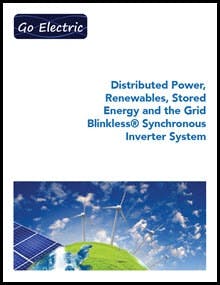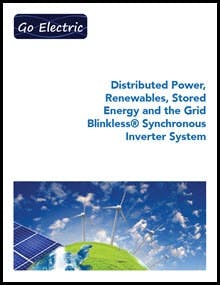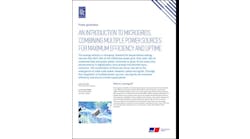A new white paper from Go Electric explores how a synchronous inverter can help the nation’s electrical infrastructure accept power from a variety of inputs including distributed generation, smart grid initiatives and renewable microgrids.
Get the full report.
According to the authors, renewable energy sources typically produce less power in a more uncontrolled fashion when compared with other non-hydrocarbon based energy sources, such as nuclear. But the smaller power outputs and lower costs of renewables present advantages for distributed power generation systems, especially when a battery is part of the system. Reduced loads, optimized renewable energy usage and significant reductions in energy loss to power transmission lines are just a few of those benefits.
One of the biggest challenges is that wind and solar energy, the most common renewable energy sources, typically run without voltage or frequency control, which inhibits their ability to interface directly with the grid. Renewables-based distributed power systems require power electronics such as an inverter to correct frequency, voltage and phase angle to convert the system’s DC power to the AC power that the grid requires. According to the paper, “sophisticated, highly adaptable power electronics coupled with local generation and storage in distributed generation applications could have profound effects on cyclic grid loading and the ratio between base load and peak load.”
The paper presents Go Electric’s Blinkless Synchronous Inverter System as a way to ensure large scale adoption of renewables in the grid. Blinkless combines “the security and stability of a UPS with the interfacing functions of a renewable grid tie and the re-syncing blink less transfer of a synchronous generator system with fast peak shaving and overload protections.”
“The ability to produce energy in a sporadic and unpredictable way but use the energy in a fashion that can supply all the required power at the required time would truly enable the large scale adaptation of renewable energy.” — Go Electric, “Distributed Power, Renewables, Stored Energy, and the Grid: Blinkless Synchronous Inverter System”
Blinkless has the ability to seamlessly transition between grid parallel mode and grid isolated mode. Grid parallel mode “allows for the introduction of energy from renewable sources to reduce the demand on the grid,” according to the report, while grid isolated mode allows the system to function as an uninterruptible power supply in the event of an outage. In essence, when the inverters are used in grid isolated mode, they create renewable microgrids. “The nonsynchronous generators, battery and renewable sources are all synced into the microgrid by the Blinkless systems.”
The paper presents a number of typical uses for Blinkless including utility, industry, residential, military and government applications.
Download the full report, “Distributed Power, Renewables, Stored Energy, and the Grid: Blinkless Synchronous Inverter System” to learn more about how Go Electric’s inverter can lead to the widespread adoption of renewables in the grid.









